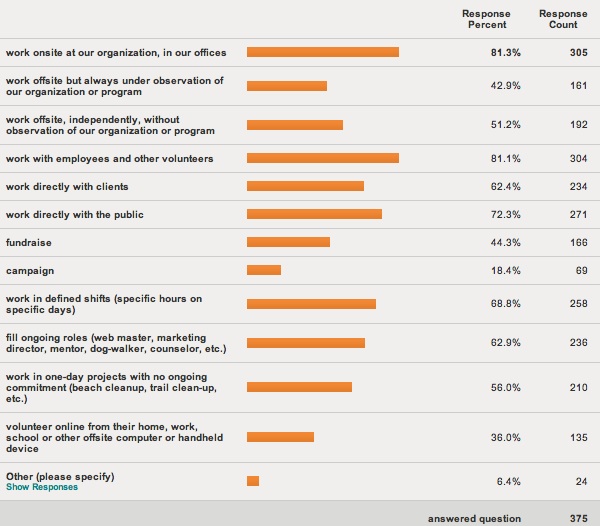 Egads, another breathless story about crowdsourcing, one that says it’s new (it’s not) and that it’s all about doing work that nonprofits don’t have paid employees to do. Argh!
Egads, another breathless story about crowdsourcing, one that says it’s new (it’s not) and that it’s all about doing work that nonprofits don’t have paid employees to do. Argh!
I’m not against crowdsourcing or microvolunteering or whatever we’re calling it these days. As I’ve said for many years, these can be very effective forms of virtual volunteering – perhaps not so much in getting critical work done for an organization, but, rather, for getting more people engaged with an organization such that they might be moved to volunteer more, in more substantial ways, to give a financial gift, and to tell their friends about their positive experience with the nonprofit.
My beef with the crowdsourcing bandwagon is three-fold:
- It’s not a new practice. Not at all. It’s the oldest forms of virtual volunteering, a practice that’s been around for more than 30 years. USENET newsgroup were my favorite place to find and post crowdsource opportunities for nonprofits and causes I supported back in the mid-1990s.
- Creating crowdsourcing opportunities, or microvolunteering tasks, or microtasks, or whatever we want to call them for volunteers (I called them “byte-sized” opportunities back in the 1990s – the name didn’t catch on), takes a LOT of work:
- You (the nonprofit) have to create meaningful assignments that can be done in just a few seconds or minutes by dozens, even hundreds, of people – not just busy work that isn’t really going to have any value to the organization nor to the volunteer. As anyone that works at a nonprofit knows, that’s easier said than done!
- You have to come up with some way to track what volunteers are contributing to the project, so you can review what’s been submitted in a timely manner and leverage such, as well as so volunteers can be thanked and further encouraged to engage with the organization.
- You have to come up with some way to measure the impact of the project, beyond number of volunteers that participated, if you want to justify spending the time and resources to engage in this form of virtual volunteering.
For instance, say you want volunteers to tag photos on Flickr: someone from the organization has to upload the photos, has to create written guidelines for how the photos are to be tagged in an easy-to-understand way, has to look over how volunteers are tagging the photos to make sure such is being done appropriately (and to delete those tags which aren’t appropriate), and has to track all of the volunteers that contributed so they can be thanked and invited to participate in something else, or to otherwise support the organization. The vast majority of nonprofits I know of do NOT have the resources to do that!
- Crowdsourcing often DOESN’T work. Nonprofits tend not to blog about failures. Yet, I hear from them after workshops frequently, telling me how their attempts to engage people in microvolunteering has failed: few people submitted logo ideas, or voted in the contest that might help them get funding, or provided advice on that tech question the nonprofit had. Those breathless media stories convinced them that hundreds, even thousands, would turn out online to help – and few, if any, actually did.
I created several crowdsourcing opportunities when I directed the Virtual Volunteering Project. One of my favorites was asking people to come up with tag lines for virtual volunteering itself – anyone could email in a slogan idea, and dozens of people did (that’s right – WE came up with “volunteer in your pajamas” – or pyjamas – YEARS before anyone else did!). But I didn’t do it because I really needed help getting a tag line; rather, I did it to get lots of people excited about the Virtual Volunteering Project, to get as many people involved in an online activity as I could on the project’s behalf, in order to encourage more people to work on more substantial activities with us and other organizations as online volunteers, and to get more people talking about virtual volunteering. And make no mistake: it took a lot of work on my part to make this successful: I had to think about where and how I was going to communicate the campaign, what the wording of the message would be, and how I would track and respond to submissions. It didn’t take tons of time – but it did take time, at least a few hours.
A misconception about microvolunteering — and, indeed, about all volunteering, not just virtual volunteering — is that the goal is to get work done, or to get work done for free. These are old paradigms regarding volunteering that so many of us have worked for a very long time to move away from. Volunteering is about so much more: it’s about building relationships with the community, increasing the number of people advocating for your organization and even supporting it financially, demonstrating transparency, and even targeting specific demographics for involvement in your work.
So, by all means, yes, let’s get excited about crowdsourcing, microvolunteering, and all other forms of virtual volunteering. Let’s keep talking about it. But let’s also stay realistic: it takes a LOT of time and expertise on the part of the nonprofit or other mission-based organization to create successful crowdsourcing opportunities. Let’s do a better job of detailing what it takes to create these type of opportunities, so organizations really can leverage crowdsourcing – rather than breaking hearts.
Also see:




